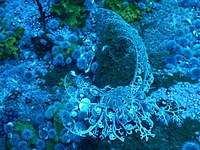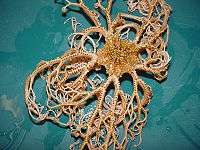Basket star
Basket stars, sometimes referred to as a "Shetland Argus",[1] are a taxon of brittle stars. They are treated as a suborder Euryalina[2] or order Euryalida.[3] Many of them have characteristic repeatedly branched arms. They generally live in deep sea habitats. However, they have been observed near 15 m or less in Plettenberg Bay, South Africa. In the wild they may live up to 35 years. They weigh up to 5 kilograms (11 lb). Like other echinoderms, basket stars lack blood and achieve gas exchange via their water vascular system.
| Basketstars | |
|---|---|
| Astroboa nuda basket star feeding at night in the Red Sea | |
| Scientific classification | |
| Kingdom: | |
| Phylum: | |
| Class: | |
| Order: | |
| Suborder: | Euryalina Lamarck, 1816 |
| Families | |
|
Asteronychidae | |
The basket stars are the largest ophiuroids with Gorgonocephalus stimpsoni measuring up to 70 cm in arm length with a disk diameter of 14 cm.[4]
Systematics and phylogeny
The fossil record of this group is rather poor and only dates back to Carboniferous.[5] Basket stars are divided into the following families:
- Asteronychidae
- Asteroschematidae
- Gorgonocephalidae
- Euryalidae
Gallery
 A basket star, located in an area known as "Star Wall", near Maori Bay, Cape Town, South Africa at a depth of approximately 28 m.
A basket star, located in an area known as "Star Wall", near Maori Bay, Cape Town, South Africa at a depth of approximately 28 m.- Close-up of Astroboa nuda basket star arm
 Basket star taken from the Atlantic Ocean
Basket star taken from the Atlantic Ocean
References
- "Shetland Argus". Merriam-Webster. Retrieved 29 May 2015.
- "Euryalina". Integrated Taxonomic Information System.
- Smith, A.B.; Paterson, G.L.J. (1995). "Ophiuroid phylogeny and higher taxonomy: Morphological, molecular and palaeontological perspectives". Zool. J. Linn. Soc. 114.
- Grzimek's Animal Life Encyclopedia. 1. Gale Cengage. 2003.
- Clarkson, E.; Clarkson, E.N.K. (1998). Invertebrate Palaeontology and Evolution (4 ed.). Wiley-Blackwell.
External links
- Jo, Yeo Sam (16 October 2014). "Singapore angler catches basket star: 5 things to know about the sea creature". The Straits Times.